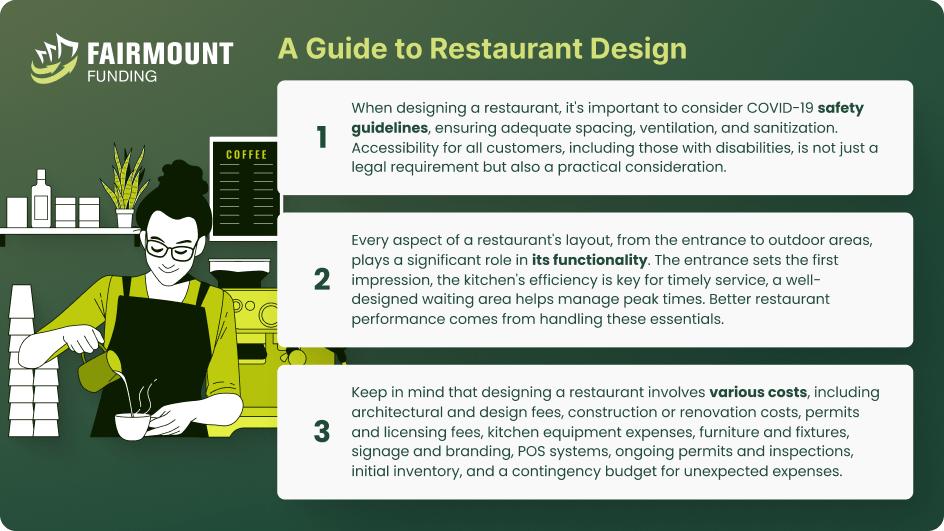
Designing a restaurant can be a multifaceted yet gratifying endeavor for real estate investors. In the hospitality industry, well-thought-out restaurant renovations can differentiate a thriving establishment from a struggling one. This explains why 65% of restaurant operators plan to spend on remodeling, equipment, and expansion within the next six months.
A restaurant’s layout, ambiance, and overall aesthetics are pivotal in creating a memorable dining experience that keeps customers returning for more. Configuring the space helps maximize functionality, traffic flow, and seating capacity, which can significantly impact profitability. That is why balancing accommodating diners comfortably and ensuring smooth kitchen operations is essential.
Attention to detail can be the key to creating a lasting impression and ensuring long-term success in the competitive restaurant industry. In this post, we will cover what to consider when remodeling a restaurant and how you can financially prepare for it.
Remodeling a Restaurant vs. Building a New Restaurant
Moving into an existing restaurant can offer several benefits for prospective restaurant owners. Firstly, it can significantly reduce the startup time and costs. You can often inherit a fully equipped kitchen and an established customer base, allowing you to start generating revenue much faster than building a new restaurant.
Additionally, existing restaurants may have established relationships with suppliers and vendors. Doing so makes it easier to source ingredients and materials. This can streamline the operational aspects and reduce the initial financial burden.
However, designing a restaurant that already exists comes with its own set of challenges. One of the biggest obstacles is aligning the existing space with your vision and concept. Renovations may involve substantial costs and time, especially if the layout or design needs significant alterations. Dealing with outdated infrastructure or complying with new health and safety regulations can also be demanding. Moreover, there might be unforeseen issues that can disrupt your timeline and budget.
Building a new restaurant from the ground up can be a good idea when you have a unique concept that demands a specific design or location. This approach offers complete creative control over the restaurant’s layout and aesthetics. It is particularly suitable for those aiming to establish a distinctive brand identity or occupy a specific niche in the market.
Nevertheless, there are disadvantages to building a restaurant. The most prominent challenge is the higher initial investment and longer lead time. It can help to account for construction costs, permits, and the time it takes to build and market your establishment. Furthermore, building a new restaurant may require extensive marketing efforts to attract a customer base since you do not have the advantage of an existing clientele.
Factors to Consider When Designing a Restaurant
You must consider several critical factors to ensure its success when designing a restaurant. By addressing these aspects thoughtfully, you can create an inviting and functional space that caters to your customers’ needs while adhering to current health protocols and maximizing your business’s profitability.
- COVID Safety Guidelines: In the wake of the pandemic, incorporating COVID-19 safety measures into your restaurant’s design is paramount. This includes creating adequate spacing between tables, implementing effective ventilation systems, and providing hand sanitizing stations. Additionally, flexible floor plans that allow for easy adjustments to accommodate changing regulations can be instrumental in ensuring the safety of both customers and staff.
- Accessibility: Designing a restaurant accessible to all patrons, including those with disabilities, is a legal requirement and a moral and practical consideration. Ensure your layout includes ramps or elevators, wide aisles, and accessible restrooms.
- Funding: Remodeling a restaurant can be expensive. That is why you must have a clear budget and know how to allocate funds wisely before applying for a restaurant loan. Consider construction costs, interior decor, and equipment. Securing sufficient funding ensures that your vision for the restaurant can come to fruition without compromising quality or safety.
- Target Market: Understanding your target market is pivotal in shaping your restaurant’s design. Your interior decor, menu offerings, and overall ambiance should align with the preferences and expectations of your intended clientele. Conduct market research to identify your target demographic’s desires and tailor your restaurant design accordingly.
What can you include in your restaurant design floor plan?
Designing a restaurant is a multifaceted endeavor that necessitates careful consideration of various components within the floor plan. Each element, from the entrance to outdoor areas, plays a vital role in shaping the establishment’s overall functionality, flow, and ambiance. By taking cues from experts in designing restaurant interiors, we can explore the significance of these critical inclusions:
Entrance
The entrance sets the first impression for diners, making it a key element when designing a restaurant. A welcoming and visually appealing entrance area can entice potential customers and establish the restaurant’s theme or identity. It is also essential to ensure that the entrance complies with accessibility requirements, providing easy access for all patrons.
Kitchen
The kitchen is the heart of any restaurant. Efficient kitchen design is necessary to streamline food preparation and ensure timely service. Consider factors like the placement of cooking stations, storage areas, and easy access for staff to move between the kitchen and dining areas.
Waiting Area
A well-designed waiting area is essential for accommodating guests during peak times. It should be comfortable and provide a seamless transition from the entrance to the dining room. Effective space planning can help manage waitlists and create a positive first impression.
Dining Room
The dining room layout should maximize seating capacity while maintaining a comfortable and inviting atmosphere. Consider factors like table placement, booth options, and lighting to create distinct dining zones catering to various group sizes and preferences.
Restroom
Restrooms should be easily accessible, clean, and well-maintained. Their design should align with the overall aesthetics of the restaurant and comply with accessibility standards. Adequate signage is also crucial to guide patrons to these facilities.
Payment Station
The payment station should be strategically located for easy access by diners and staff. It should also allow for a smooth and efficient payment at the table, counter, or dedicated area.
Full-service Bar
If your restaurant includes a bar, its design should facilitate bartenders’ work while providing an enjoyable experience for patrons. Proper storage for liquor and barware, comfortable seating, and a visually appealing bar area are essential.
Staff Quarters or Back Room
A functional back-of-house area is crucial for staff to perform their duties efficiently. This includes spaces for food storage, dishwashing, and staff break areas. An organized back room contributes to the overall smooth operation of the restaurant.
Emergency Exits
Safety should be a top priority in restaurant design. Marked emergency exits that meet safety regulations ensure the well-being of both customers and staff in case of emergencies.
Outdoor Area
If your restaurant has an outdoor dining area, its design should complement the restaurant’s overall aesthetic while providing diners comfort and functionality. Adequate seating, shading, and landscaping can enhance the outdoor dining experience.
Costs to Expect When Designing a Restaurant
Designing a restaurant involves various costs that vary widely depending on the size, concept, and extent of a restaurant remodel. Here are some of the costs to expect when designing a restaurant:
- Architectural and Design Fees: Hiring an architect and interior designer is imperative for creating a functional and appealing restaurant space. Their fees range from 5% to 15% of the total construction or renovation costs.
- Construction or Renovation Costs: This encompasses the expenses associated with building or renovating the physical space, like structural changes, flooring, walls, ceilings, plumbing, electrical work, and HVAC systems. Costs vary significantly but range from $100 to $400 per square foot.
- Permits and Licensing: Acquiring the necessary permits and licenses, like building permits, health permits, alcohol licenses, and signage permits, can be a substantial cost. Costs vary by location, ranging from a few thousand dollars to tens of thousands.
- Kitchen Equipment and Appliances: Outfitting the kitchen with commercial-grade equipment is another significant expense. The cost depends on the size and type of cuisine but can easily reach tens of thousands of dollars.
- Furniture and Fixtures: Tables, chairs, bar stools, lighting fixtures, and decor are essential elements that contribute to the restaurant’s ambiance. Costs can vary whether you will have budget-friendly options or high-end selections.
- Signage and Branding: Designing and installing exterior and interior signage that reflects your restaurant’s branding can cost several thousand dollars. This includes menu boards, outdoor signage, and decor elements.
- POS System and Technology: Implementing a point-of-sale (POS) system, reservation platforms, and other technology solutions can cost several thousand dollars upfront, along with ongoing software subscription fees.
- Permits and Inspections: Ongoing costs for renewing permits and undergoing health and safety inspections should be factored into your budget.
- Initial Inventory: To stock your restaurant with food, beverages, and supplies, budget for an initial inventory. The cost will depend on your menu offerings and storage capacity.
- Contingency Budget: Setting aside a contingency fund (typically 10% to 20% of the total project cost) to cover unexpected expenses or changes during the design and construction process is wise.
Creating a budget that accounts for all these costs is essential. The same goes for regularly monitoring your expenditures to stay on track throughout the restaurant renovation process.
Designing a Restaurant FAQs
Should I renovate an existing restaurant or build a new one?
The decision to renovate an existing restaurant or build a new one depends on several factors. Renovating an existing restaurant can be cost-effective and time-efficient since you can inherit equipment, infrastructure, and an established customer base. On the other hand, building a new restaurant gives you creative control over the design and layout, ideal for unique concepts or specific locations.
Why do I need a restaurant floor plan?
A restaurant floor plan is fundamental for effective space utilization and efficient operations. It visually represents your restaurant’s layout, including seating arrangements, kitchen placement, and customer traffic flow. A well-designed floor plan maximizes seating capacity, ensures customer comfort, and optimizes kitchen workflows. It also aids in complying with safety and accessibility regulations and helps you make informed decisions about furniture, decor, and overall ambiance.
How much does it cost to open a restaurant?
The cost of opening a restaurant varies based on concept, size, and level of customization. You can expect to invest $100,000 to $1 million to open a restaurant. Critical expenses include rent or property acquisition, construction or renovation costs, permits and licenses, kitchen equipment, furniture, branding and marketing, initial inventory, and staffing.
Apply for a Restaurant Loan to Renovate and Boost Your Business's Profitability
Designing a restaurant demands balancing creativity, practicality, and financial foresight. The decisions made during the design and renovation process can significantly impact the restaurant’s long-term success and profitability. Therefore, real estate investors need to approach this endeavor with careful consideration and a clear understanding of the factors at play.
KEY TAKEAWAYS
- Some key factors to consider when designing a restaurant include COVID-19 guidelines, accessibility, and your target market.
- Each element of a restaurant design plays a vital role in shaping the establishment’s overall functionality, flow, and ambiance.
- Designing a restaurant involves various costs that vary widely depending on the size, concept, and extent of a restaurant remodel.


